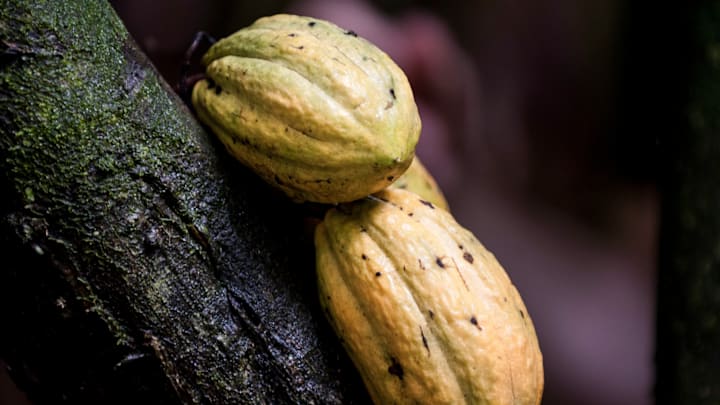Nearly 500 years after the legend of El Dorado drew Spanish conquistadors into the South American rainforest, the hunt for Amazonian treasure is still alive. Today’s adventurers aren’t searching for ancient cities or empires of gold, though. The treasure they’re after is confirmed to be real, and it’s available to purchase by the bar.
The quest for endangered, wild cacao in the Amazon rainforest is the subject of a new podcast from Kaleidescope, a company co-founded by Mental Floss co-founder Mangesh Hattikudur. In Obsessions: Wild Chocolate, host Rowan Jacobson follows intrepid bean hunters through some of the most dangerous locations on Earth in search of the ultra-rare ingredient. To get there, they first have to avoid cocaine smugglers, flash floods, and giant anacondas.
“You can make a living doing it if everything goes right, but you’re taking crazy risks in order to do so,” Jacobson tells Mental Floss. “A million things can go wrong and always do.”
Adventurous Eating
To many people who have sampled chocolate made from wild cacao, the reward is worth the risks. Though the crop is native to South America, two thirds of cacao produced today is farmed in West Africa. Commercial strains have been bred for maximum yield, and subtle flavor nuances have been lost over the centuries. This means that to people who grew up eating Hershey’s, wild Amazonian chocolate is more than a fancier version of what they’re used to—it’s something entirely new.
“There are these fragrances going on that you don’t find in normal chocoIate,” Jacobson says. “It tastes like dried fruit and fresh fruit and flowers—some of it is really floral. Almost sort of like pipe smoke. Really interesting flavors.”
Chocolate connoisseur are paying for more than complexity when they purchase a $55 bar of wild chocolate. Considering how rare the cacao beans are, and what it takes to harvest them, that price is a bargain.
Turning the ingredient into a sellable product only became feasible a couple of decades ago, as the craft chocolate world went mainstream and more consumers were willing to pay $5-plus for a candy bar. At that point, wild chocolate was thought by many to be extinct. Its existence was known only to a handful of scientists and the people who lived in the rainforests where it grew.
Ark of the Cacao Nib

German cacao hunter Volker Lehmann was one of the first people to give these obscure plants a global platform. After learning that locals had been harvesting and processing wild cacao in remote regions of Bolivia for hundreds of years, he took the product out of the jungle and treated it using Swiss techniques. The result was an artisan chocolate bar that set the culinary world ablaze.
As Jacobson puts it: “Then the hunt was on."
Now, more people are competing to collect the Amazon’s botanical riches and turn them into something delicious. One of them is Luisa Abram, a Brazilian chocolatier spotlighted on Jacobson’s podcast. Part Willy Wonka and part Indiana Jones, Abram first began trekking into the rainforest to track down wild chocolate in 2014. She returned from that first trip with nearly 45 pounds of cacao beans she’d already dried and fermented to prevent decay (an impressive feat in a place that can see 12 feet of rainfall per year). After many months of experimentation, she had developed a chocolate formula she was proud to share with the world, and today her company, Luisa Abram chocolate, exports to seven countries out of Brazil.
Transforming an ingredient few people have tasted into a commercial good is one challenge of the business. Because these wild cacao varieties can’t be farmed, anyone who works with them must be mindful of sustainability. Abram does this by collaborating with Indigenous communities with deep roots in the plant’s native environment. Local families who help harvest cacao receive part of the profits, which gives them an incentive to protect the forest where it grows.
Sustainable Snacking
The agriculture industry is one of the greatest threats facing the rainforest. Roughly 80 percent of deforested land in the Amazon basin is used to raise livestock today. But as Abram’s work demonstrates, locals don’t necessarily have to choose between conserving the rainforest and protecting their livelihoods.
“It turns out that this is actually a really cool way to prevent deforestation,” Jacobson says. “Because this cacao that grows throughout the jungle is totally wild, so it kind of gives people a way to earn a living off a living forest rather than cutting it down for cattle ranches.”
There are many good reasons to keep rainforests alive; the preservation of exotic chocolate is just a delicious perk.
Tune in here weekly for new episodes of OBSESSIONS: Wild Chocolate.
